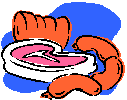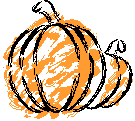Text C. THERE ARE MANY KINDS OF FOOD
Since most of us eat their mealswith a family,suppose we talk about family meals.
 There are first the foods which are rich in animal protein, like milk, meat, eggs, fish and cheese. It is easy to build an adequate diet for growth when we can use liberal amounts of the protein foods which come from animals. Milk and milk products form a special class of foods because in addition to the excellent protein they contain, they also are rich in calcium, which is one of the important minerals used in building bones.
There are first the foods which are rich in animal protein, like milk, meat, eggs, fish and cheese. It is easy to build an adequate diet for growth when we can use liberal amounts of the protein foods which come from animals. Milk and milk products form a special class of foods because in addition to the excellent protein they contain, they also are rich in calcium, which is one of the important minerals used in building bones.
Next, suppose we discuss the foods which come from plants. This is a very large group which includes fruits, vegetables and cereals. In fact, a large number of people in the world have to depend on plants rather than meats to give them protein because this kind of food can be produced most cheaply. It also provides vitamins and minerals for our diet.
 Have you ever thought of all the kinds of foods which come from cereals? Think first of bread — made from wheat, from rye, from oats, from corn. You would probably name next the many, many kinds and forms of cereal products such as oatmeal or cornflakes. Then there are the so called "pastes" like macaroni, spaghetti, vermicelli and the many other forms of paste. Barley is used in delicious hearty soups. Buckwheat is used in griddle-cakes. Man has learned to strip grains of the highly nutritious outer brown coats, but many of these elements have been put back into the "enriched" cereal products. Bread, breakfast cereals and corn meal can all be purchased now in the enriched form.
Have you ever thought of all the kinds of foods which come from cereals? Think first of bread — made from wheat, from rye, from oats, from corn. You would probably name next the many, many kinds and forms of cereal products such as oatmeal or cornflakes. Then there are the so called "pastes" like macaroni, spaghetti, vermicelli and the many other forms of paste. Barley is used in delicious hearty soups. Buckwheat is used in griddle-cakes. Man has learned to strip grains of the highly nutritious outer brown coats, but many of these elements have been put back into the "enriched" cereal products. Bread, breakfast cereals and corn meal can all be purchased now in the enriched form.
 Let us talk next about fruits and vegetables. Can you imagine how drab our meals would be if suddenly we had no gardens or orchards? We would miss most of the color in our meals — the color of a ripe tomato, a bright orange, the greenness of fresh peas, the golden glow of squash, the rosiness of red apples! We would also miss much flavor in our meals - the tartness of a crisp apple,thesweet sour of grapefruit or fresh lemon. Children too would miss fruits and vegetables.
Let us talk next about fruits and vegetables. Can you imagine how drab our meals would be if suddenly we had no gardens or orchards? We would miss most of the color in our meals — the color of a ripe tomato, a bright orange, the greenness of fresh peas, the golden glow of squash, the rosiness of red apples! We would also miss much flavor in our meals - the tartness of a crisp apple,thesweet sour of grapefruit or fresh lemon. Children too would miss fruits and vegetables.
Nutritionists know that besides the satisfactions to eye and tongue which fruits and vegetables give, their very color and tartness are related to their nutritive value.
Yellow, orange and green are important colors when we consider nutritive value. Associated with these colors in fruits and vegetables is the important vitamin A. The yellow food pigment carotene is changed in our bodies to the real vitamin A. Although carotene is a yellow pigment, it is also found along with the green pigment of plants. The darker the green color in a vegetable or the brighter the yellow, the more carotene the food contains. Perhaps you have heard or read that green, unbleached celery and green cabbage are more nutritious than the white varieties. Now you know why. This is a useful fact to remember when you shop at the greengrocer's.
The tartness of grapefruit, oranges and lemons which makes our mouths water when we smell them, leads us to another necessary vitamin. This one is called vitamin C, or ascorbic acid. Vitamin C is also found in vegetables like those of the cabbage family, which includes also Brussels sprouts. Turnips, onions and white potatoes also contain valuable amounts of this vitamin. Vitamin C does not like the heat of cooking, so you are advised to serve one raw fruit and one raw vegetable each day.
Sugars and fats furnish extra calories for our diet. Fats also have another important function in nutrition. Many of our natural foods like meat, milk, eggs, cheese, nuts and even some vegetables contain fat. Fat in a meal has the property of making us feel satisfied. Children and most adults like some extra fat, for example butteror margarine on bread or fat used in cooking.
Now sugar is another matter. We have become sugar-eaters. We eat ten times as much as our great-grandmothers did. But sugar in moderation is a good energy food. Fruits and the sweeter vegetables contain sugar which should be considered. Sugar is also capable of making us feel satisfied at the end of a meal. There are lots of sweet foods everywhere, and doctors, nutritionists and dentists keep saying "Don't use too much!"
From “Feeding Your Baby and Child” by
B. M. Spock and M. E. Lowenberg (Adapted)
======================VOCABULARY===================
| cereals, n | хлебные злаки |
| wheat, n | пшеница |
| rye, n | рожь |
| oats, n | овес, овсяная крупа (каша) |
| corn, n | кукуруза, маис; зерно, хлеба (пшеница) |
| paste(s), n | макаронные изделия, итальянские блюда из макарон |
| barley, n | ячмень |
| delicious, a | вкусный |
| hearty, a | обильный (о еде) |
| buckwheat, n | гречиха, гречневый |
| griddle-cakes, n | оладьи, лепешки |
| breakfast cereals | каша из круп на завтрак |
| drab, a | бесцветный, однообразный |
| ripe, a | спелый |
| squash, n | кабачок, тыква |
| flavor, n | вкус, букет, аромат, запах |
| tart, a | кислый, едкий, терпкий |
| crisp, a | хрустящий |
| celery, n | сельдерей |
| turnip, n | репа |
| onion, n | лук |
| cabbage, n | капуста |
| fats, n | жиры |
==========================================================
I. Learn the words to text C. Make sure you can translate them both from English into Russian and from Russian into English.
II. Read the text ‘There Are Many Kinds of Food’. Answer the questions below.
1. What foods are rich in animal protein?
2. What foods come from plants?
3. What foods come from cereals?
4. What is the value of fruits and vegetables?
5. What vitamins can we get from fruits and vegetables?
6. What are important colours in fruits and vegetables? Why?
7. What is the function of fats?
8. What foods can contain fats?
9. Is sugar a good energy food?
10. What foods produce vitamins and minerals for our diet?
III. Underline the suffixes in the following words. Translate the words:
growth, cheaply, highly, greenness, suddenly, tartness, rosiness, brighter, important, moderation, nutritionist, satisfaction.
IV. Divide the following sentence into sense groups. Translate.
Milk and milk products form a special class of foods because in addition to the excellent protein they contain, they also are rich in calcium, which is one of the important minerals used in building bones.
V. Read the text ‘There Are Many Kinds of Food’ carefully. Find the sentences with subordinate clauses. Define what types they belong to. Translate the sentences.
VI. Name 5 – 10 things which are
· rich in animal proteins;
· rich in vitamins and minerals;
· rich in fats;
· cereals;
· fruits;
· vegetables.
VII. Match up the color with the appropriate foods:
| 1. green | a) orange |
| 2. yellow | b) tomato |
| 3. orange | c) squash |
| 4. red | d) apple |
| e) grapefruit | |
| f) celery | |
| g) turnip |
VIII. Match up the vitamins with the appropriate foods:
| 1. Vitamin A | a) oranges |
| 2. Vitamin C | b) cabbage |
| c) celery | |
| d) brussels sprouts | |
| e) turnips | |
| f) onions | |
| g) lemons |
IX. Exclude foods that don’t contain fats:
cheese, meat, eggs, apples, milk, turnip, cabbage, nuts, macaroni, wheat, squash.
X. Make up short reports on the following topics:
1. The foods which come from plants.
2. The foods which come from animals.
